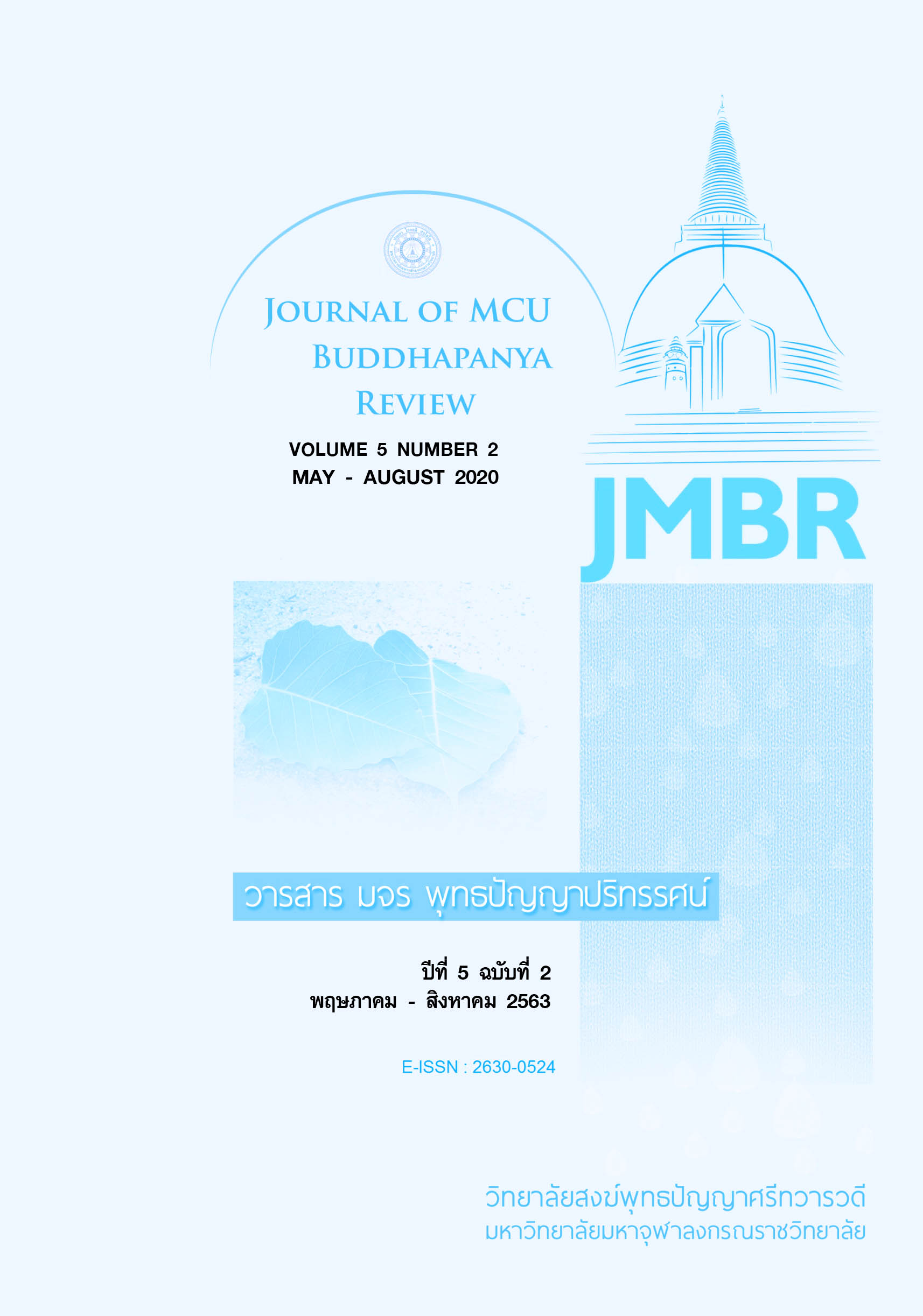โมเดลความสัมพันธ์เชิงสาเหตุความตั้งใจใช้บริการเทรนเนอร์ออนไลน์ผ่านโซเชียลมีเดียของผู้บริโภคในเขตกรุงเทพมหานครและปริมณฑล
คำสำคัญ:
เฟซบุ๊ก, ความตั้งใจใช้บริการ, โมเดลสมการโครงสร้าง, ความไว้วางใจบทคัดย่อ
งานวิจัยครั้งนี้มีวัตถุประสงค์เพื่อพัฒนาโมเดลความสัมพันธ์เชิงสาเหตุความตั้งใจใช้บริการเทรนเนอร์ออนไลน์ผ่านโซเชียลมีเดียของผู้บริโภคในเขตกรุงเทพมหานครและปริมณฑล และเพื่อตรวจสอบความสอดคล้องของโมเดลความสัมพันธ์เชิงสาเหตุที่พัฒนาขึ้นกับข้อมูลเชิงประจักษ์ เครื่องมือที่ใช้ในการวิจัย ได้แก่ แบบสอบถามออนไลน์ กลุ่มตัวอย่าง ได้แก่ ผู้ที่เคยใช้บริการเทรนเนอร์ออนไลน์ผ่านโซเชียลมีเดียและอาศัยในเขตกรุงเทพมหานครและปริมณฑล จำนวน 280 คน ได้มาโดยสุ่มตัวอย่างแบบสะดวก เครื่องมือที่ใช้ในการวิจัยได้แก่ แบบสอบถามออนไลน์แบบมาตรประมาณค่า 7 ระดับ เทคนิคการวิเคราะห์โมเดลสมการโครงสร้างโมเดลประกอบด้วย 5 ตัวแปรได้แก่ 1) ด้านการรับรู้ประโยชน์ 2) ด้านรับรู้ความสะดวกในการใช้งาน 3) ด้านเนื้อหาในโซเชียลมีเดีย 4) ด้านความไว้วางใจ 5) ด้านการตั้งใจใช้บริการเทรนเนอร์ออนไลน์
ผลการวิเคราะห์โดเดลความสัมพันธ์เชิงสาเหตุพบว่า โมเดลความสัมพันธ์เชิงสาเหตุที่พัฒนาขึ้นสอดคล้องกับข้อมูลเชิงประจักษ์เป็นอย่างดี โดยมีค่าสถิติไคสแควร์ () เท่ากับ 110 องศาอิสระ (df) เท่ากับ 90, CMIN/Df = 1.23 GFI = 0.94 AGFI = 0.92 SRMR = 0.05 RMSEA = 0.03 และค่าสัมประสิทธิ์การพยากรณ์เท่ากับ 0.94 แสดงว่าตัวแปรในโมเดลความสัมพันธ์เชิงสาเหตุสามารถอธิบายโมเดลความสัมพันธ์เชิงสาเหตุความตั้งใจใช้บริการเทรนเนอร์ออนไลน์ผ่านโซเชียลมีเดียของผู้บริโภค ได้ร้อยละ 94 พบว่า ด้านการรับรู้ประโยชน์ ด้านรับรู้ความสะดวกในการใช้งาน ด้านเนื้อหาในโซเชียลมีเดีย ด้านความไว้วางใจ และ ด้านการตั้งใจใช้บริการเทรนเนอร์ออนไลน์ ส่งผลร่วมกันต่อความตั้งใจใช้บริการเทรนเนอร์ออนไลน์ผ่านโซเชียลมีเดียของผู้บริโภค
เอกสารอ้างอิง
กรวินท์ ชูพันธุ์. (2560). ปัจจัยที่มีผลต่อการตัดสินใจกลับมาใช้บริการซ้ำของผู้ใช้บริการเทรนเนอร์ออนไลน์:
กรณีศึกษาเฟซบุ๊ก. กรุงเทพฯ: มหาวิทยาลัยกรุงเทพ.
Chupan, K. (2017). Factors influencing the decision to repurchase online personal trainer: case study facbook. Bangkok :
Bangkok University.
กฤติยาภรณ์ มีเกษ. (2558). การศึกษาองค์ประกอบที่ส่งผลต่อการผลิตงานวิจัยของอาจารย์มหาวิทยาลัยรังสิตในสาขาเทคโนโลยีสารสนเทศที่เกี่ยวข้อง. วาสารมหาวิทยาลัยนอร์ทกรุงเทพ, 4(2),6.
Meekate, K. (2015). A study of factors affectedon research production of Rangsit university professor in the information technology and related fields.
พัทธ์ธนนันท์ ธนประกอบกุล. (2558). แผนธุรกิจ ทู ฟิตเนส. กรุงเทพฯ : มหาวิทยาลัยกรุงเทพ.
Thanaprakobkul, P. (2015). Business plan for to fitness. Bangkok : Bangkok University.
พิศุทธิ์ อุปถัมภ์. (2557). ความไว้วางใจและลักษณะธุรกิจผ่านสื่อสังคมออนไลน์ส่งผลต่อความตั้งใจซื้อสินค้าผ่านสื่อสังคมออนไลน์. กรุงเทพฯ: มหาวิทยาลัยกรุงเทพ.
Oppatum, P. (2014). Trust and characteristics of social commerce affecting the purchase intention via social media. Bangkok : Bangkok university.
พุฒิสรณ์ ย่อมเจริญ, 2558. การแบ่งปันข้อมูลการดูแลสุขภาพบนเครือข่ายสังคมออนไลน์. กรุงเทพฯ: มหาวิทยาลัยกรุงเทพ.
Yomcharorm, P. (2015). Healthcare information sharing through social networks. Bangkok: Bangkok University.
รัศมิ์ลภัส วรเดชธนันกุล. (2558). ความไว้วางใจ การสื่อสารแบบปากต่อปากเชิงบวก และการรับรู้ถึงประโยชน์ที่มีผลต่อความตั้งใจซื้อแพ็กเกจทัวร์ผ่านเว็บไซต์ท่องเที่ยวของผู้บริโภคในจังหวัดระยอง. กรุงเทพฯ : มหาวิทยาลัยกรุงเทพ.
Woradechthanankul, R. (2017). Trust, positive word of mouth, and perceived relative advantage affecting package tours’ purchase intention via travel websites of customers in Rayong province. Bangkok: Bangkok university.
Agag, G., & El-Masry, A. A. (2016). Understanding consumer intention to participate in online travel community and effects on consumer intention to purchase travel online and WOM: An integration of innovation diffusion theory and TAM with trust. Computers in human behavior, 60, 97-111.
Cheng, Y.C., Chen, J.C. & Yen. J.D. (2015). Optically modulated photoswitchable fluorescent proteins yield improved biological imaging sensitivity. Journal of the American Chemical Society, 137(40), 12764-12767.
Athapaththu, J. C., & Kulathunga, K. M. S. D. (2018). Factors Affecting Online Purchase Intention: A Study Of Sri Lankan Online Customers.
Järvinen, J., Ohtonen, R., & Karjaluoto, H. (2016, January). Consumer acceptance and use of Instagram. In 2016 49th Hawaii International Conference on System Sciences (HICSS) (pp. 2227-2236). IEEE.
Kim, A. J., & Johnson, K. K. (2016). Power of consumers using social media: Examining the influences of brand-related user-generated content on Facebook. Computers in Human Behavior, 58, 98-108.
Ooi, K. B., & Tan, G. W. H. (2016). Mobile technology acceptance model: An investigation using mobile users to explore smartphone credit card. Expert Systems with Applications, 59, 33-46.
Oyedele, A., & Simpson, P. M. (2018). Streaming apps: What consumers value. Journal of Retailing and Consumer Services, 41, 296-304.
Risson, V., Saini, D., Bonzani, I., Huisman, A., & Olson, M. (2016). Patterns of treatment switching in multiple sclerosis therapies in US patients active on social media: application of social media content analysis to health outcomes research. Journal of medical Internet research, 18(3), e62.
Wang, Wang & Liu (2016). A novel exfoliation strategy to significantly boost the energy storage capability of commercial carbon cloth. Advanced materials, 27(23), 3572-3578.



